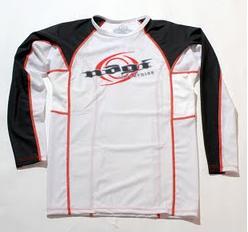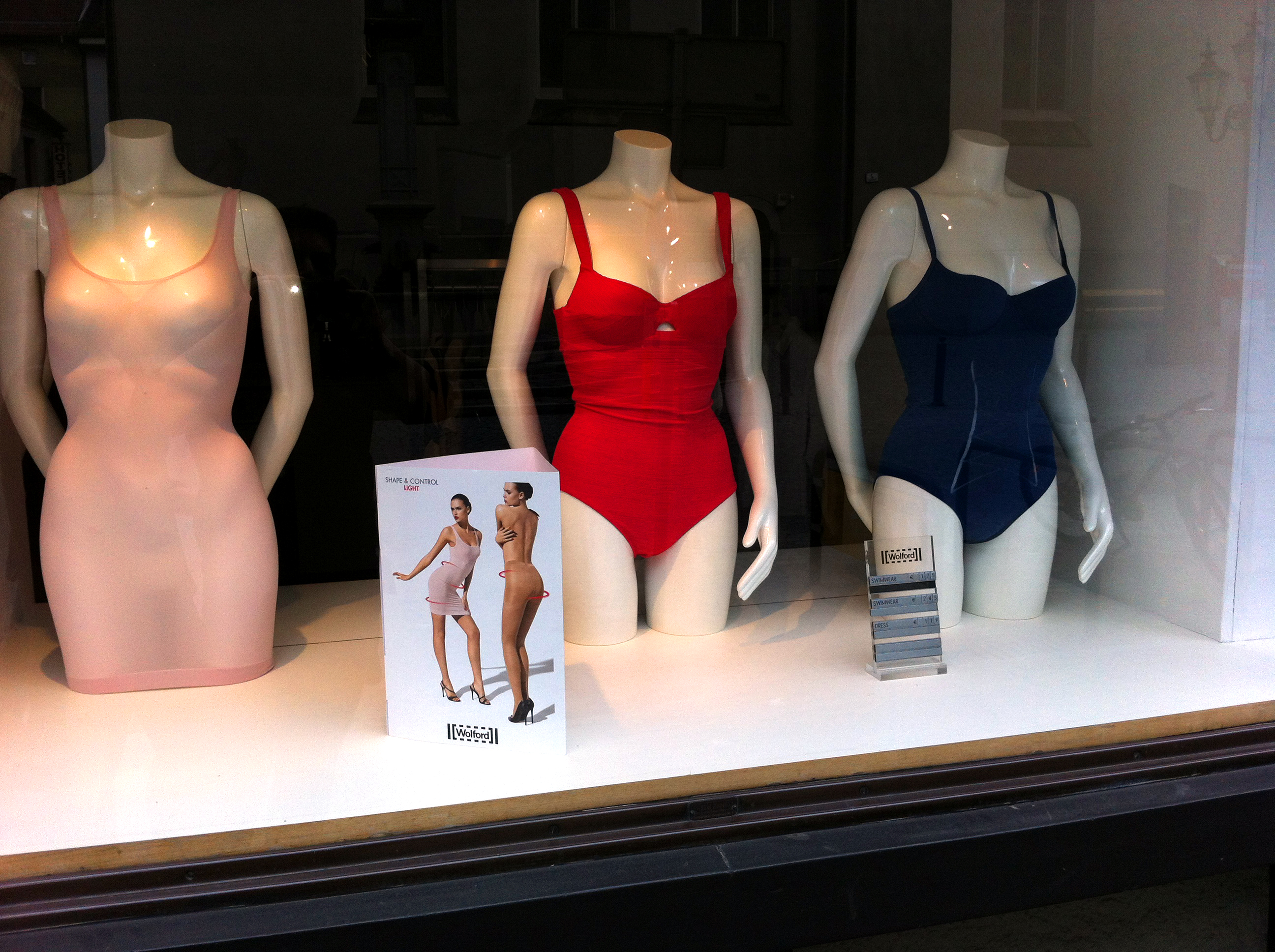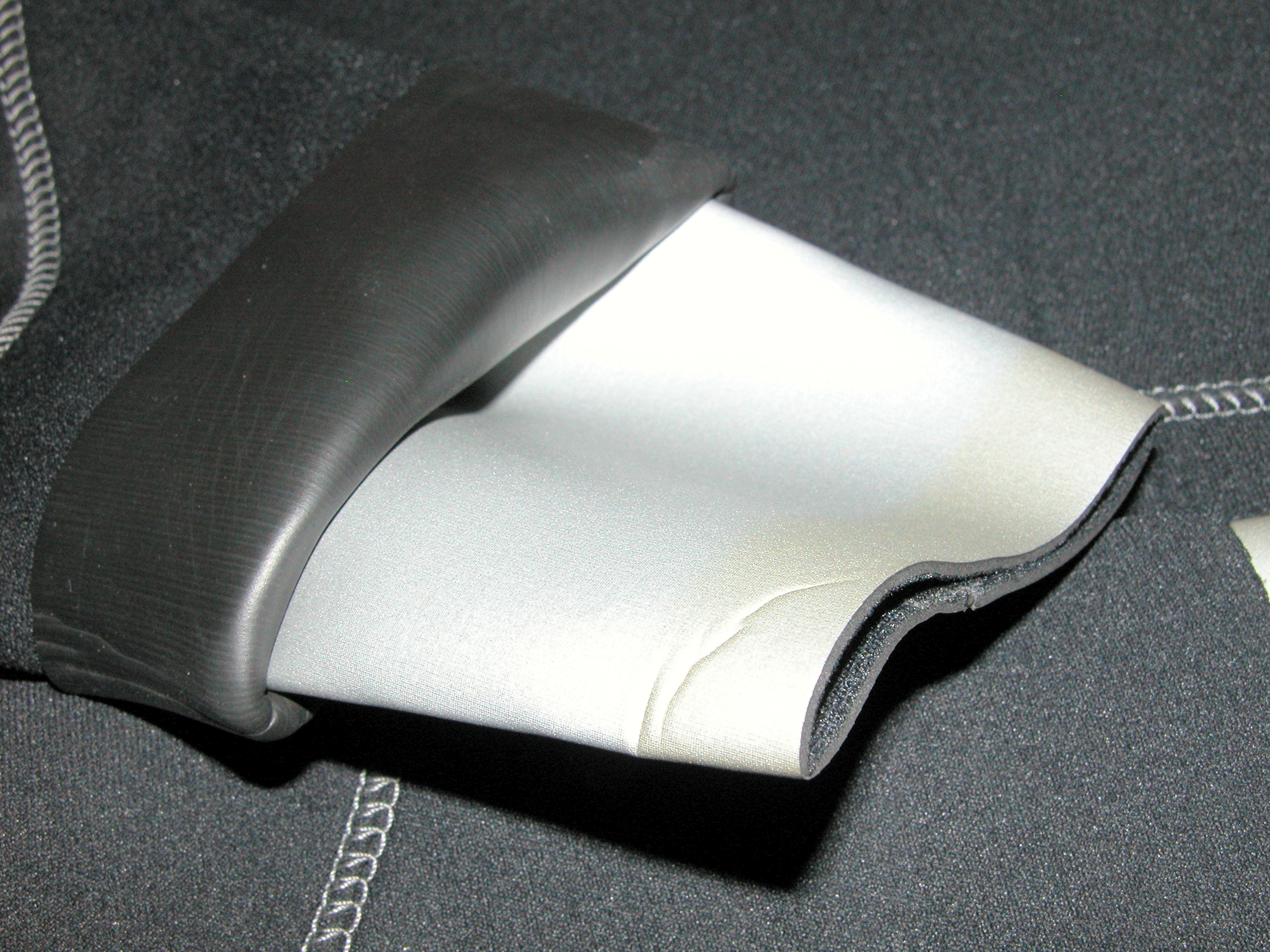|
Skin-tight
A skin-tight garment is a garment that is held to the skin usually by elastic tension using some type of stretch fabric. Commercial stretch fabrics ('elastomerics') such as spandex or elastane (widely branded as 'Lycra') came onto the market in 1962, and revolutionized many areas of the clothing industry. A wide variety of clothing may be made to be skin-tight, and it is common for clothing to be skin-tight for some uses, such as in stockings, bodystockings, swimsuits and women's bras. History and types Leotard In 1886, the name leotard was given to a one-piece skin-tight garment that covers the torso including the crotch, but not the legs or arms. The garment was named after French acrobatic performer Jules Léotard (1838–1870), many years after his death, who wore the garment in his acrobatic act. In the early 20th century, use of leotards was mainly confined to circus and acrobatic shows, but were also worn by professional dancers, such as the showgirls of Broadway. Leota ... [...More Info...] [...Related Items...] OR: [Wikipedia] [Google] [Baidu] |
Bodystocking
A bodystocking or body stocking is a one-piece skin-tight garment that covers the torso, legs and sometimes the arms of the wearer. It is a foundation garment or an article of lingerie usually made from a sheer fabric similar to that used for stockings or pantyhose, or from fishnet, lace or an opaque material, or a variation of these materials. A bodystocking differs from a unitard, which is worn as an outfit or article of clothing, and a leotard, which is used as a practice garment or performance costume for acrobats, gymnasts and other similar performers. Designed to be revealed, but not to be too revealing, bodystockings may be worn as undergarments by performers such as belly dancers and exotic dancers. Description Oftentimes bodystockings are made of sheer fabric and are worn with or without undergarments such as a bra. Bodystockings normally come in only two sizes, especially when they use stretch material. A body stocking may be worn for the smooth line it gives ... [...More Info...] [...Related Items...] OR: [Wikipedia] [Google] [Baidu] |
Swimsuit
A swimsuit is an item of clothing designed to be worn by people engaging in a water-based activity or water sports, such as swimming, diving and surfing, or sun-orientated activities, such as sun bathing. Different types may be worn by men, women, and children. A swimsuit can be described by various names, some of which are used only in particular locations, including swimwear, bathing suit, swimming costume, bathing costume, swimming suit, swimmers, swimming togs, bathers, cossie (short for "costume"), or swimming trunks for men, besides others. A swimsuit can be worn as an undergarment in sports that require a wetsuit such as water skiing, scuba diving, surfing, and wakeboarding. Swimsuits may also be worn to display the wearer's physical attributes, as in the case of beauty pageants or bodybuilding contests, and glamour photography and magazines like the annual '' Sports Illustrated Swimsuit Issue'' featuring models and sports personalities in swimsuits. There is a ... [...More Info...] [...Related Items...] OR: [Wikipedia] [Google] [Baidu] |
Bodysuit
A bodysuit is a one-piece form-fitting or skin-tight garment that covers the torso and the crotch, and sometimes the legs, hands, and feet, and cannot be used as a swimsuit. The style of a basic bodysuit is similar to a one-piece swimsuit and a leotard, though the materials may vary. A bodysuit, unlike a swimsuit or leotard, has snaps, hooks or velcro at the crotch. Thong or T-front thong bodysuits usually have the crotch opening moved up to the front to underbelly area to increase the wearer's comfort. A bodysuit may have sleeves and varying shoulder strap and collar styles. Bodysuits can be made from a number of fabrics, including cotton, lace, nylon, etc. In general, textile bodysuits include expandable fiber such as spandex for a better fit to the shape of the body. A bodysuit is normally worn with trousers or a skirt. The top, torso part may act as a top for the smooth line it gives or because it cannot become untucked from trousers or skirt. They may also be ... [...More Info...] [...Related Items...] OR: [Wikipedia] [Google] [Baidu] |
Leotard
A leotard () is a unisex skin-tight one-piece garment that covers the torso from the crotch to the shoulder. The garment was made famous by the French acrobatic performer Jules Léotard (1838–1870). There are sleeveless, short-sleeved, and long-sleeved leotards. A variation is the unitard, which also covers the legs. Leotards are worn by acrobats, gymnasts, dancers, figure skaters, athletes, actors, wrestlers, and circus performers both as practice garments and performance costumes. They are often worn with ballet skirts on top and tights or sometimes bike shorts as underwear. As a casual garment, a leotard can be worn with a belt; it can also be worn under overalls or short skirts. Leotards are entered by stepping into the legs and pulling the sleeves over the shoulders. Scoop-necked leotards have wide neck openings and are held in place by the elasticity of the garment. Others are crew necked or polo necked and close at the back of the neck with a zipper or sn ... [...More Info...] [...Related Items...] OR: [Wikipedia] [Google] [Baidu] |
One-piece Swimsuit
A one-piece swimsuit most commonly refers to swimwear worn primarily by women and girls when swimming in the sea or in a swimming pool, playing water polo, or for any activity in the sun, such as sun bathing. Today, the one-piece swimsuit is usually a skin-tight garment that covers the torso, although some designs expose the back or upper chest. Before the popularity of the two-piece swimsuit, and then the bikini, virtually all women's swimwear completely covered at least the wearer's torso, and men also wore similar swimsuits. While the bikini has increasingly found popular acceptance since the 1960s, the one-piece swimsuit has maintained a place on beaches to this day. The most common type of one-piece suit is the maillot (a term that is not generally used anymore) or ''tank suit'', which resembles a sleeveless leotard or bodysuit. There are variants of the one-piece swimsuit, including halterneck styles and plunge front swimsuits, as well as wrap-round ("surplice") and bandea ... [...More Info...] [...Related Items...] OR: [Wikipedia] [Google] [Baidu] |
Spandex
Spandex, Lycra, or elastane is a synthetic fiber known for its exceptional elasticity. It is a polyether-polyurea copolymer that was invented in 1958 by chemist Joseph Shivers at DuPont's Benger Laboratory in Waynesboro, Virginia, US. The generic name "spandex", which is an anagram of the word "expands", is the preferred name in North America. In continental Europe, it is referred to by variants of "elastane", including (France), (Germany, Sweden), (Spain), (Italy), and (Netherlands); and in the UK, Ireland, Portugal, Spain, Latin America, Australia, and New Zealand, it is primarily known as "Lycra". Brand names for spandex include Lycra (made by The Lycra Company, previously a division of DuPont Textiles and Interiors), Elaspan (The Lycra Company), Acepora (Taekwang Group), Creora (Hyosung), INVIYA ( Indorama Corporation), ROICA and Dorlastan (Asahi Kasei), Linel (Fillattice), and ESPA ( Toyobo). History In the post-World War II era, DuPont Textiles Fibers Departm ... [...More Info...] [...Related Items...] OR: [Wikipedia] [Google] [Baidu] |
Lingerie
Lingerie (, , ) is a category of primarily women's clothing including undergarments (mainly brassieres), sleepwear, and lightweight robes. The choice of the word is often motivated by an intention to imply that the garments are alluring, fashionable, or both. In a 2015 US survey, 75% of women and 26% of men reported having worn sexy lingerie in their lifetime. Lingerie is made of lightweight, stretchy, smooth, sheer or decorative fabrics such as silk, satin, Lycra, charmeuse, chiffon, or (especially and traditionally) lace. These fabrics can be made of various natural fibres like silk or cotton or of various synthetic fibres like polyester or nylon. Etymology The word ''lingerie'' is a word taken directly from the French language, meaning undergarments, and used exclusively for more lightweight items of female undergarments. The French word in its original form derives from the French word '' linge'', meaning 'linen' or 'clothes'. Informal usage suggests visually appea ... [...More Info...] [...Related Items...] OR: [Wikipedia] [Google] [Baidu] |
Foundation Garment
image:Kim_Kardashian_at_Madame_Tussauds.jpg, Kim Kardashian in Shapewear-dress A foundation garment (also known as shapewear or shaping underwear) is an undergarment designed to impermanently alter the wearer's female body shape, body shape, to achieve what some view as a more fashionable figure. The function of a foundation garment is not to enhance a bodily feature (as would, for example, a padded bra) but to make it look more presentable. Specific styles of foundation garments have been essential to some fashion movements, and were required in some social situations during various fashion periods. History Women have worn foundation garments, such as corsets and brassieres, for a very long time. Foundation garments were patented by Marion M Chubby in 1965 (categorized in elastic corsets). Debenhams recorded a 75% increase in shapewear sales between 2009 and 2013. Description Foundation garments are worn to modify body shape. They usually require technological advances ... [...More Info...] [...Related Items...] OR: [Wikipedia] [Google] [Baidu] |
Stockings
Stockings (also known as hose, especially in a historical context) are close-fitting, variously elastic garments covering the leg from the foot up to the knee or possibly part or all of the thigh. Stockings vary in color, design, and transparency. Today, stockings are primarily worn for fashion and aesthetics, usually in association with mid-length or short skirts. History Historically, even though the word ''sock'' is at least as ancient in origin, what men normally wore were often referred to as stockings, probably especially when referring to longer hose. The word ''stock'' used to refer to the bottom "stump" part of the body, and by analogy the word was used to refer to the one-piece covering of the lower trunk and limbs of the 15th century—essentially tights consisting of the ''upper-stocks'' (later to be worn separately as knee breeches) and ''nether-stocks'' (later to be worn separately as ''stockings''). (See Hose.) Before the 1590s, stockings were made of woven ... [...More Info...] [...Related Items...] OR: [Wikipedia] [Google] [Baidu] |
Sheer Fabric
Sheer fabric is fabric which is made using thin thread or low density of knit. This results in a semi- transparent and flimsy cloth. Some fabrics become transparent when wet. Overview The sheerness of a fabric is expressed as a numerical denier which ranges from 3 (extremely rare, very thin, barely visible) to 15 (standard sheer for stockings) up to 30 (semi opaque) until 100 (opaque). The materials which can be made translucent include gossamer, silk, rayon or nylon. Sheer fabric comes in a wide variety of colors, but for curtains, white and shades of white, such as cream, winter white, eggshell, and ivory are popular. In some cases, sheer fabric is embellished with embroidered patterns or designs. A common use for sheer fabric is in curtains, which allows for sunlight to pass through during daylight, while maintaining a level of privacy. However, when it is lighter on the inside of a room than it is on the outside (such as at nighttime), then the inside of the room can ... [...More Info...] [...Related Items...] OR: [Wikipedia] [Google] [Baidu] |
Wetsuit
A wetsuit is a garment worn to provide thermal protection while wet. It is usually made of foamed neoprene, and is worn by surfers, divers, windsurfers, canoeists, and others engaged in water sports and other activities in or on water. Its purpose is to provide thermal insulation and protection from abrasion, ultraviolet exposure, and stings from marine organisms. It also contributes extra buoyancy. The insulation properties of neoprene foam depend mainly on bubbles of gas enclosed within the material, which reduce its ability to conduct heat. The bubbles also give the wetsuit a low density, providing buoyancy in water. Hugh Bradner, a University of California, Berkeley physicist, invented the modern wetsuit in 1952. Wetsuits became available in the mid-1950s and evolved as the relatively fragile foamed neoprene was first backed, and later sandwiched, with thin sheets of tougher material such as nylon or later spandex (also known as lycra). Improvements in the way jo ... [...More Info...] [...Related Items...] OR: [Wikipedia] [Google] [Baidu] |
Pantyhose
Pantyhose, called sheer tights, or tights, are close-fitting legwear covering the wearer's body from the waist to the toes. Mostly considered to be a garment for women and girls, pantyhose first appeared on store shelves in 1959 for the advertisement of new design panties (Allen Gant's product, 'Panti-Legs') as a convenient alternative to stockings and/or control panties which, in turn, replaced girdles. Like stockings or knee highs, pantyhose are usually made of nylon, or of other fibers blended with nylon. Pantyhose are designed to: * Be attractive in appearance, * Hide physical features such as blemishes, bruises, scars, hair, spider veins, or varicose veins, * Reduce visible panty lines, Glen Raven, Inc.: Turnpage advertisement "How do gals get this sleek bell bottom look without the bumps of garters and panties?'' - ''They don't wear any. They wear Glen Raven Panti-Legs in Cantrece.", USA, 1966 and * Ease chafing between feet and footwear, or between thighs. Besides ... [...More Info...] [...Related Items...] OR: [Wikipedia] [Google] [Baidu] |




_(cropped).jpg)

.jpg)





